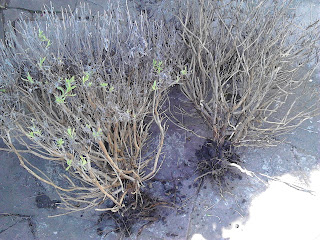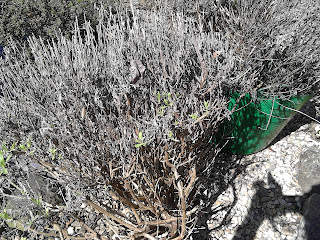I wrote recently about one battle I had with nature - the unusually late frost that threatened to ruin the developing display of flowers on our wisteria and other plants. Well, (spoiler alert) the wisteria survived, and in fact thrived, but I have another casualty to report, which set me thinking about whether we gardeners can ever truly claim to have nature under control.
Gardening, by definition, is interfering with nature, from capturing a piece of it for our own enjoyment, to drastically altering the characteristics of the soil, landscape, or even the plants themselves. Such manipulation enables us to grow things in places that they otherwise would not, giving us experiences of touch, taste, smell and sight that without taking control of the environment we would be denied.
Abbotsbury is just one garden I've visited which demonstrates the ability of gardeners to create micro-climates and soil conditions in order to grow what we enjoy, rather than what might naturally occur. But nature is a force more powerful than any individual gardener, so what happens when nature tries to take back control? How far can nature be defied or overcome? How much effort should we devote to protecting tender plants that would not grow in our gardens without our help?
 |
| The lavender is dead - long live the lavender |
Gardening, by definition, is interfering with nature, from capturing a piece of it for our own enjoyment, to drastically altering the characteristics of the soil, landscape, or even the plants themselves. Such manipulation enables us to grow things in places that they otherwise would not, giving us experiences of touch, taste, smell and sight that without taking control of the environment we would be denied.
Abbotsbury is just one garden I've visited which demonstrates the ability of gardeners to create micro-climates and soil conditions in order to grow what we enjoy, rather than what might naturally occur. But nature is a force more powerful than any individual gardener, so what happens when nature tries to take back control? How far can nature be defied or overcome? How much effort should we devote to protecting tender plants that would not grow in our gardens without our help?
Sadly, we can't always overcome all of the challenges nature throws our way, and recently I resigned myself to the fact that the wetness of the winter on the slopes of the hills outside Cardiff had claimed a victim in the form of my lavender hedge. I had attempted to manipulate conditions in order to create a tiny piece of Provence (although it is English lavender) in this part of South Wales.
The primary issue is drainage. Lavender will withstand the cold of a typical winter here. However, excessive water in the ground is not to its liking, as it originates in much drier areas. I'd added plenty of grit and gravel to the ground when I planted three lavenders a few years ago, and as you can see from the top picture they did well. They attracted loads of bees, smelt amazing and, interspersed with boulders, really did add a tiny flavour of the south of France as we brushed past them along the gravel path between them and the "Rock Border".
 |
| They just had to go |
But it seems the rainfall this past winter was too much for them. I watched for a while to see if they would recover and start growing fresh shoots again, but to no avail. As you can see, they looked pretty sorry for themselves and even into April produced only one or two new shoots, showing no signs of producing a tall bushy display this year. After a few weeks of watching closely, I reconciled myself to the fact that on this occasion nature had won, and they had to go. Out they came.
But my message to you is that there is no need to give up. Nature claims occasional victories but we keep trying. The answer, of course, is not to consider nature as an adversary, but to work with it. We need to understand the conditions the plants want and provide them. I have an azalea growing in the Japanese area in the garden. I planted it in ericaceous compost, mulch it with the same a couple of times a year, and feed it with azalea specific feed. It is still going strong. The azaleas I have grown in pots fell victim not to the soil conditions but to vine weevils.
After losing a feature plant, you can decide to change your plans and try something different. I removed a hibiscus that was not really thriving and have replaced it with an acer which I expect to perform much better in the same spot. I love lavender too much not to have any though, so stubbornly, I have replanted the hedge with plants grown from cuttings from the old ones a couple of years ago. Stubbornness alone though is unlikely to succeed. Some pragmatism is called for, so I have added plenty more grit to this area in order to help the lavender through next winter.
 GREEN FINGERS TIP - Succession planning is always a good idea in the garden. If you have favourite plants that you simply could not bare to be without, then propagate them. Take cuttings and collect and sow the seeds. Grow them on in pots or elsewhere in the garden. Then if the parent plants ever die, you will have ready made younger replacements ready to take their place.
GREEN FINGERS TIP - Succession planning is always a good idea in the garden. If you have favourite plants that you simply could not bare to be without, then propagate them. Take cuttings and collect and sow the seeds. Grow them on in pots or elsewhere in the garden. Then if the parent plants ever die, you will have ready made younger replacements ready to take their place.
But is this trying to defeat nature, or just trying to work with it? I am trying to help something grow that would not normally thrive easily in a garden that gets as much winter rainfall as we do. But to do so, I am acknowledging my powerlessness in the face of natural conditions and climate, and adapting to suit natural forces. Does this mean nature has beaten me? Is it really a battle, or a partnership? Whatever the answer, my quest to maintain a tiny piece of Provence in my garden goes on and the replacement plants have better drainage than their predecessors.
Please tell me about your own battles (or partnerships) with nature, using the comments box below, or via my facebook page. I'd love to hear about things you are trying to grow against the odds, so get in touch.


No comments:
Post a Comment
Note: only a member of this blog may post a comment.